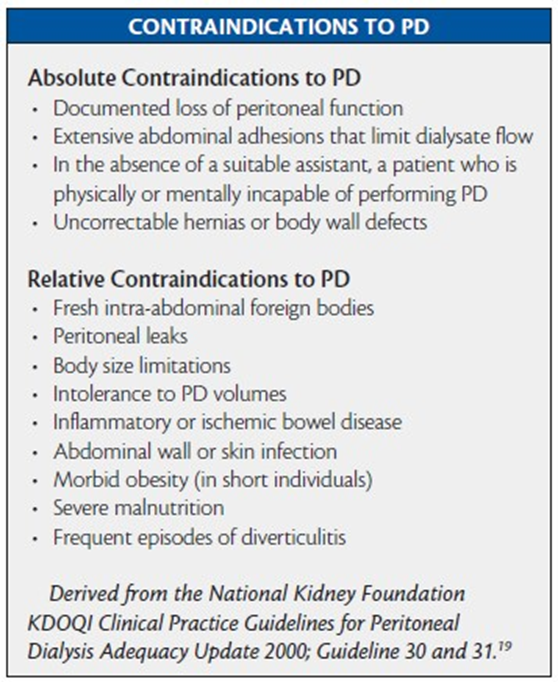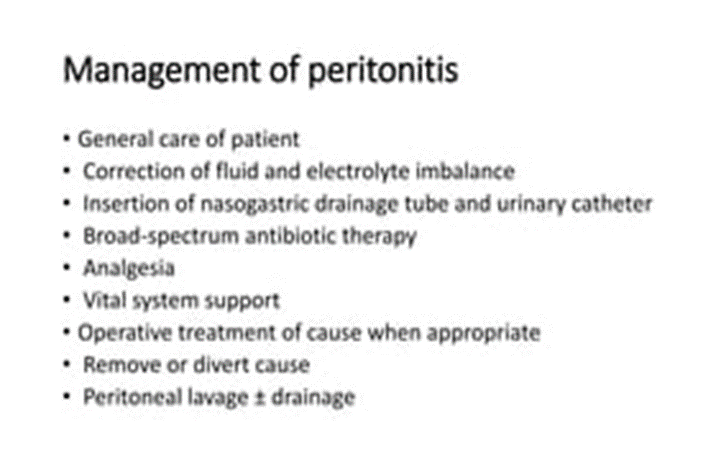A client is diagnosed with chronic kidney disease and needs to begin dialysis. Which condition entered on the client's medical record should the nurse recognize as a contraindication for peritoneal dialysis?
Type 2 diabetes mellitus.
Nephrotic syndrome history.
Latent hepatitis C
Crohn's disease with colectomy
The Correct Answer is D
A. Type 2 diabetes mellitus
Type 2 diabetes mellitus is not a contraindication for peritoneal dialysis. In fact, peritoneal dialysis can be a suitable option for individuals with diabetes who require renal replacement therapy. However, the presence of diabetes may require additional considerations and close monitoring.
B. Nephrotic syndrome history
Having a history of nephrotic syndrome is not a contraindication for peritoneal dialysis. Peritoneal dialysis can be used in individuals with various causes of chronic kidney disease, including those with nephrotic syndrome.
C. Latent hepatitis C
Latent hepatitis C alone may not be an absolute contraindication for peritoneal dialysis. However, the decision to initiate peritoneal dialysis would depend on the overall health status of the client, the degree of liver involvement, and the risk of infection. Close monitoring and appropriate precautions may be necessary.
D. Crohn's disease with colectomy
Crohn's disease with colectomy is considered a contraindication for peritoneal dialysis. Surgical alterations in the abdomen, such as colectomy, can lead to adhesions or other complications that may interfere with the effectiveness of peritoneal dialysis. In such cases, alternative forms of dialysis, such as hemodialysis, may be considered.

Nursing Test Bank
Naxlex Comprehensive Predictor Exams
Related Questions
Correct Answer is B
Explanation
A. Activity level of bowel sounds:
Bowel sounds are important to assess, but they may not directly influence or be influenced by the abdominal pain associated with chronic pancreatitis.
B. Eating patterns and dietary intake.
Clients with chronic pancreatitis often experience abdominal pain exacerbated by the intake of food, especially fatty meals. Monitoring the client's eating patterns and dietary intake is crucial for identifying triggers that may worsen the abdominal pain. By understanding the relationship between food intake and pain, the nurse can provide guidance on dietary modifications to help manage the symptoms.
C. Level and amount of physical activity:
While physical activity is important for overall health, it may not be the primary factor contributing to or alleviating the abdominal pain in a client with chronic pancreatitis.
D. Color and consistency of feces:
Monitoring the color and consistency of feces is important for assessing pancreatic function, but it may not be the most immediate factor to address in the context of managing abdominal pain. Dietary patterns are more directly related to pain management in this case.
Correct Answer is D
Explanation
A. Encourage regular turning:
While turning is important for preventing complications like pressure ulcers, in this acute situation, addressing fluid imbalance and potential sepsis take precedence.
B. Monitor skin for breakdown:
Monitoring for skin breakdown is essential but is not the most critical intervention at this moment.
C. Assess wound drainage daily:
Daily assessment of wound drainage is important for evaluating the status of the surgical site. However, in this situation of potential anastomosis leakage with signs of systemic infection and hypotension, immediate interventions to stabilize the client's condition are of higher priority.
D. Strict IV fluid replacement:
This is the correct answer. The client is displaying signs of systemic infection (fever) and possible sepsis (tachycardia, hypotension), which might be due to an anastomosis leakage following gastric bypass surgery. Ensuring adequate IV fluid replacement is crucial to address hypotension, maintain perfusion, and support hemodynamic stability in this critical situation.

Whether you are a student looking to ace your exams or a practicing nurse seeking to enhance your expertise , our nursing education contents will empower you with the confidence and competence to make a difference in the lives of patients and become a respected leader in the healthcare field.
Visit Naxlex, invest in your future and unlock endless possibilities with our unparalleled nursing education contents today
Report Wrong Answer on the Current Question
Do you disagree with the answer? If yes, what is your expected answer? Explain.
Kindly be descriptive with the issue you are facing.
